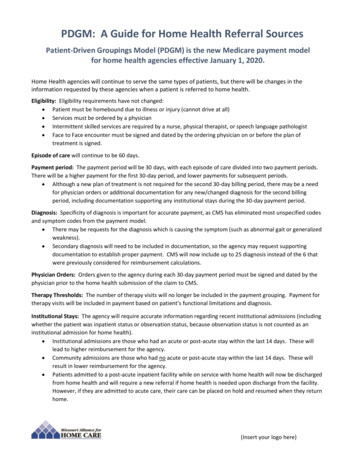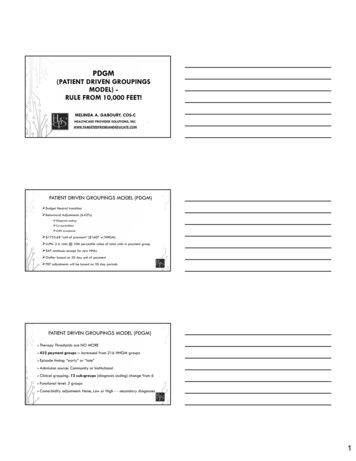
Transcription
PDGM: A Guide for Home Health Referral SourcesPatient-Driven Groupings Model (PDGM) is the new Medicare payment modelfor home health agencies effective January 1, 2020.Home Health agencies will continue to serve the same types of patients, but there will be changes in theinformation requested by these agencies when a patient is referred to home health.Eligibility: Eligibility requirements have not changed: Patient must be homebound due to illness or injury (cannot drive at all) Services must be ordered by a physician Intermittent skilled services are required by a nurse, physical therapist, or speech language pathologist Face to Face encounter must be signed and dated by the ordering physician on or before the plan oftreatment is signed.Episode of care will continue to be 60 days.Payment period: The payment period will be 30 days, with each episode of care divided into two payment periods.There will be a higher payment for the first 30-day period, and lower payments for subsequent periods. Although a new plan of treatment is not required for the second 30-day billing period, there may be a needfor physician orders or additional documentation for any new/changed diagnosis for the second billingperiod, including documentation supporting any institutional stays during the 30-day payment period.Diagnosis: Specificity of diagnosis is important for accurate payment, as CMS has eliminated most unspecified codesand symptom codes from the payment model. There may be requests for the diagnosis which is causing the symptom (such as abnormal gait or generalizedweakness). Secondary diagnosis will need to be included in documentation, so the agency may request supportingdocumentation to establish proper payment. CMS will now include up to 25 diagnosis instead of the 6 thatwere previously considered for reimbursement calculations.Physician Orders: Orders given to the agency during each 30-day payment period must be signed and dated by thephysician prior to the home health submission of the claim to CMS.Therapy Thresholds: The number of therapy visits will no longer be included in the payment grouping. Payment fortherapy visits will be included in payment based on patient’s functional limitations and diagnosis.Institutional Stays: The agency will require accurate information regarding recent institutional admissions (includingwhether the patient was inpatient status or observation status, because observation status is not counted as aninstitutional admission for home health). Institutional admissions are those who had an acute or post-acute stay within the last 14 days. These willlead to higher reimbursement for the agency. Community admissions are those who had no acute or post-acute stay within the last 14 days. These willresult in lower reimbursement for the agency. Patients admitted to a post-acute inpatient facility while on service with home health will now be dischargedfrom home health and will require a new referral if home health is needed upon discharge from the facility.However, if they are admitted to acute care, their care can be placed on hold and resumed when they returnhome.(Insert your logo here)
Physician Guide toMedicare HomeHealth Changes:The Patient DrivenGroupings Model(PDGM)
The Patient Driven Groupings Model (PDGM) — OverviewThe PDGM is a new payment model for Medicare certified home health agencies (HHAs).The billing cycle for home health agencies under PDGM will be for 30 day periods ratherthan 60 days. The model is a case mix model that groups patients for payment purposesinto categories based on certain patient characteristics. Case mix payment groups are generated using variables from five general categories: Admission source–institutional (has had an inpatient stay within 14 days of admission to home healthservices)–community (no inpatient stay within 14 days of admission to home health services) Timing of the period (first in a series of 30 day periods “early”, second and later 30day periods “late”) Clinical grouping based on the primary diagnosis from twelve diagnostic categories(see chart below)Clinical GroupsThe Primary Reason for Home Health ServicesMusculoskeletal rehabilitationTherapy (PT, OT, SLP)for a musculoskeletal conditionNeuro/stroke rehabilitationTherapy (PT, OT, SLP) for a neurological or strokeconditionWounds: post-op wound aftercareand skin/ non-Surgical wound careAssessment, treatment& evaluation of a surgicalwound(s); assessment, treatment & evaluation ofnon-surgical wounds, ulcers, burns and other lesions.Behavior health careAssessment, treatment & evaluation of psychiatricand substance abuse conditionsComplex nursing InterventionsAssessment treatment & evaluation of complexmedical & surgical conditions including IV, TPN,enteral nutrition, ventilator, and ostomiesMedication and Management,Teaching and Assessment (MMTA).This clinical group is subdivided into six additionalclinical groupsMMTA (Surgical aftercare)Assessment, evaluation, teaching, and medicationmanagement for surgical after careMMTA (Cardiac/circulatory)Assessment, evaluation, teaching, and medicationmanagement for cardiac and other circulatoryrelated conditionsMMTA (Endocrine)Assessment, evaluation, teaching, and medicationmanagement for endocrine related conditionsMMTA (GI/GU)Assessment, evaluation, teaching, and medicationmanagement of gastrointestinal or genitourinaryrelated conditionsM MTA (Infectious diseases/neoplasms/blood formingdiseases)Assessment, evaluation, teaching, and medicationmanagement for conditions related to infectiousdiseases. neoplasms, and blood forming diseasesMMTA (Respiratory)Assessment, evaluation, teaching and medicationmanagement for respiratory related conditionsMMTA (Other)Assessment. evaluation, teaching and medicationmanagement for a variety of medical and surgicalconditions not previous classified1
Functional grouping based on certain assessment items from a standardized assessment tool that are further categorized as high, medium, or low. Comorbidities (secondary diagnoses) or a combination of diagnoses associated withhigh resource use. These are further categorized into none, low or high.The combination of these criteria yields 432 payment groups, as compared to 153 paymentgroups from the old payment model, making the model more complex but also moreaccurate in determining resource use. In contrast to the old model, the amount of therapya patient receives does not directly impact reimbursement. All home health services andsupplies are bundled under a single payment for the 30 day period.The low utilization payment adjustment (LUPA) is made where the number of visits in the30 day period falls below the case mix specified threshold. The threshold is between 2-6visits for each of the 432 case mix payment groups. LUPA periods are paid on a per visitbasis. The threshold is the minimum number of visits that must be provided in order toreceive the full 30 day period payment amount for that payment group.HOME HEALTH PDGM PAYMENT GROUP VARIABLES2
How Physicians Will Be Impacted Under PDGMPLAN OF CARE/ORDERSBecause the new model reduces the billing cycle for HHAs to 30 day periods agencies willneed to have the patient’s certification, POC, and all interim orders signed by the physicianmuch sooner than under the previous payment model.In order to maintain timely billing and adequate cash flow HHAs will be contacting physicians more frequently and sooner after the patient’s admission to services than in the past.Physicians should expect plans of care and verbal orders to be sent for signature withinone to two days after their completion. If the documents are not returned within oneweek, HHAs will be contacting the physician’s office. Physicians may also see an increase invisits from agency personnel to obtain signatures on outstanding plans of care/orders.FACE TO FACE ENCOUNTER (F2F)PDGM does not change the certification requirements for home health services. A F2Fencounter that is related to the primary reason for home health services will continue tobe required in order for HHAs to bill for care. The diagnosis on the encounter note doesnot need to match the primary diagnosis for home health care but the physician encountermust be related to the reason the patient requires home health services.Agencies need to obtain physician encounter notes that contain information related towhy the patient is receiving home health care.Diagnoses“UNACCEPTABLE” DIAGNOSIS CODESEach 30 day period will be placed into one of the 12 clinical groupings based on the primary diagnosis. Not all diagnoses are included in the PDGM. A diagnosis is not assigned toone of the 12 clinical groups in the payment model if it is considered an “unacceptable”diagnosis.“Unacceptable” diagnoses are those diagnoses that the federal government has determined are not appropriate or Medicare coverage of home health services.As a rule of thumb, “unacceptable” diagnoses are diagnoses that indicate nonspecific conditions or symptoms, such as, muscle weakness and unsteady gait.Typically, codes ending in “9” are not accepted because they are unspecified conditionsand codes beginning with “R” are not accepted because they are symptoms of anunderlying diagnosis. Following are commonly used “unacceptable” diagnoses.3
ICD10 CM CodeDescriptionFix NeededC34.10Malignant neoplasm of upperlobe, unspecified bronchus orlungIdentify which lung is impactedC34.30Malignant neoplasm of lowerlobe, unspecified bronchus orlungIdentify which lung is impactedC56.9Malignant neoplasm ofunspecified ovaryIdentify which ovary is impactedC65.9Malignant neoplasm of specifiedrenal pelvisIdentify which kidney isimpactedI69.30Unspecified sequelae of cerebralinfarctionIdentify the impact or deficitsfollowing the cerebral infarctI70.239Atherosclerosis of native arteriesof right leg with ulceration ofunspecified siteIdentify the location of theulcerationsI70.249Atherosclerosis of native arteriesof left leg with ulceration ofunspecified siteIdentify the location of theulcerationsI25.2Old myocardial infarctionIdentify underlying conditionsuch as coronary artery disease.I95.9Hypotension, unspecifiedIdentify underlying cause ofhypotensionM62.81Muscle weakness (generalized)Provide reason for weaknesssuch as musculoskeletal disorder,stroke, etc.M54.5Low back painIdentify the underlying cause ofthe back pain iR29.6Repeated fallsIdentify the disease process orcondition causing the fallsR00.1Bradycardia unspecifiedIdentify the underlying cause ofbradycardiaR26.0Ataxic gaitIdentify underlying cause ofataxiaR25.1Paralytic gaitIdentify underlying cause ofparalytic gaitR26.2Difficulty walking not otherwiseclassifiedIdentify underlying cause fordifficulty walkingR26.81Unsteadiness on feetIdentify underlying cause ofunsteadinessR26.89Other abnormalities of gait andmobilityIdentify underlying cause of gaitabnormalityR56.9Unspecified convulsionsIdentify the disease or conditioncausing convulsionsZ91.81History of fallsIdentify an underlying reason forthe falls4
If the HHA submits a claim with a primary diagnosis that is an “unacceptable” diagnosisthe claim will be sent back to the agency to review and resubmit with an allowed diagnosis. All diagnoses must be established by the physician and supported by the physician’sdocumentation. If the physician cannot provide any additional information to assign anacceptable diagnosis, the agency will not be able to bill for services.If a referral to the home health agency includes an “unacceptable” primary diagnosis, theagency will contact the physician upon referral for additional information. If the HHA isunable to obtain information to support an acceptable diagnosis, it may not be able toadmit the patient. If the patient has been admitted to the HHA, it may have to dischargepatient.HHAs will work with physicians to develop an acceptable diagnosis if the medical recordsupports a more appropriate diagnosis. For example, confirming which side of the body isimpacted for those conditions that require identifying laterality or determining the underlying condition for frequent falls for which the agency could appropriately intervene.COMORBID DIAGNOSESSeveral individual secondary diagnoses and combinations of secondary diagnoses contribute to the payment groups under PDGM, However, similar to the primary diagnosis,the physician documentation will need to support any diagnosis an agency reports on theclaim for services.HHAs may need to contact physicians for additional information and consultation if theybelieve the patient has other diagnoses that should be reported for which there is no documentation from the physician.MORE FREQUENT DISCHARGES AND READMISSIONSPDGM is designed to encourage, and the federal regulators instruct, agencies to dischargea patient and readmit to home health when ever a patient is transferred to a post-acutecare facility (i.e. skilled nursing facility, inpatient rehabilitation facility, long term care hospitals and Inpatient psychiatric facility). This could occur with a direct admission to postacute care or a post-acute care stay after an acute care stay.This means that the HHA agency will need to submit new plans of care and certificationsfor home health services more frequently for such patients. The agency may be contactingyou for new orders even if the plan of care has not changed.For more information about the impact on physicians of the new home health PDGMmodel as well as other home health topics, please go to www.nahc.org5
encounter that is related to the primary reason for home health services will continue to be required in order for HHAs to bill for care. The diagnosis on the encounter note does not need to match the primary diagnosis for home health care but the physician encounter must be related to the reason the patient requires home health services.










